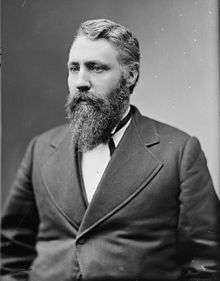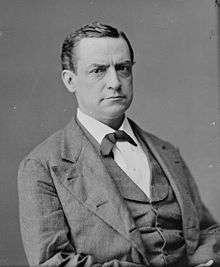1880 United States House of Representatives elections
Elections to the United States House of Representatives were held in 1880 for Representatives to the 47th Congress, and coincided with the 1880 presidential election which was won by James A. Garfield, who was a member of the House at the time.
| |||||||||||||||||||||||||||||||||||||||||||||||||||||||||||||||||||||||||||||||||||||||
All 293 seats in the U.S. House of Representatives 147 seats needed for a majority | |||||||||||||||||||||||||||||||||||||||||||||||||||||||||||||||||||||||||||||||||||||||
|---|---|---|---|---|---|---|---|---|---|---|---|---|---|---|---|---|---|---|---|---|---|---|---|---|---|---|---|---|---|---|---|---|---|---|---|---|---|---|---|---|---|---|---|---|---|---|---|---|---|---|---|---|---|---|---|---|---|---|---|---|---|---|---|---|---|---|---|---|---|---|---|---|---|---|---|---|---|---|---|---|---|---|---|---|---|---|---|
| |||||||||||||||||||||||||||||||||||||||||||||||||||||||||||||||||||||||||||||||||||||||
| |||||||||||||||||||||||||||||||||||||||||||||||||||||||||||||||||||||||||||||||||||||||
Issues such as Civil War loyalties, tariffs, graft and corruption dominated the year's elections, though none became substantive a national issue. The economy was growing stronger after emerging from a long Depression. It was in this political environment that Garfield's Republican Party gained 19 seats and regained control of the House from the Democratic Party. The Greenback Party, an emerging party of workers and farmers, also lost seats in these elections, after gaining more than a dozen two years earlier.[3][4]
Election summaries
| 131 | 10 | 151 |
| Democratic | Gb | Republican |
| State | Type | Total seats |
Democratic | Greenback | Republican | |||
|---|---|---|---|---|---|---|---|---|
| Seats | Change | Seats | Change | Seats | Change | |||
| Alabama | District | 8 | 6 | 1 | 1 | |||
| Arkansas | District | 4 | 4 | 0 | 0 | |||
| California | District | 4 | 2 | 0 | 2 | |||
| Colorado | At-large | 1 | 0 | 0 | 1 | |||
| Connecticut | District | 4 | 1 | 0 | 3 | |||
| Delaware | At-large | 1 | 1 | 0 | 0 | |||
| Florida | District | 2 | 1 | 0 | 1 | |||
| Georgia | District | 9 | 9[lower-alpha 4] | 0 | 0 | |||
| Illinois | District | 19 | 6 | 0 | 13 | |||
| Indiana | District | 13 | 5 | 0 | 8 | |||
| Iowa | District | 9 | 1 | 0 | 8 | |||
| Kansas | District | 3 | 0 | 0 | 3 | |||
| Kentucky | District | 10 | 9 | 0 | 1 | |||
| Louisiana | District | 6 | 5 | 0 | 1 | |||
| Maine[lower-alpha 5] | District | 5 | 0 | 2 | 3 | |||
| Maryland | District | 6 | 5 | 0 | 1 | |||
| Massachusetts | District | 11 | 1 | 0 | 10 | |||
| Michigan | District | 9 | 0 | 0 | 9 | |||
| Minnesota | District | 3 | 0 | 0 | 3 | |||
| Mississippi | District | 6 | 5 | 0 | 1 | |||
| Missouri | District | 13 | 7 | 4 | 2 | |||
| Nebraska | At-large | 1 | 0 | 0 | 1 | |||
| Nevada | At-large | 1 | 1 | 0 | 0 | |||
| New Hampshire | District | 3 | 0 | 0 | 3 | |||
| New Jersey | District | 7 | 3 | 0 | 4 | |||
| New York | District | 33[lower-alpha 6] | 12 | 0 | 20 | |||
| North Carolina | District | 8 | 7 | 0 | 1 | |||
| Ohio[lower-alpha 5] | District | 20 | 5 | 0 | 15 | |||
| Oregon[lower-alpha 5] | At-large | 1 | 0 | 0 | 1 | |||
| Pennsylvania | District | 27 | 7 | 2 | 18 | |||
| Rhode Island | District | 2 | 0 | 0 | 2 | |||
| South Carolina | District | 5 | 4 | 0 | 1 | |||
| Tennessee | District | 10 | 7 | 0 | 3 | |||
| Texas[lower-alpha 5] | District | 6 | 5 | 1 | 0 | |||
| Vermont[lower-alpha 5] | District | 3 | 0 | 0 | 3 | |||
| Virginia | District | 9 | 7[lower-alpha 7] | 0 | 2 | |||
| West Virginia | District | 3 | 3 | 0 | 0 | |||
| Wisconsin | District | 8 | 2 | 0 | 6 | |||
| Total | 293[lower-alpha 6] | 131[1] 44.7% |
10[1] 3.4% |
151[1] 51.5% |
||||
[[File:47 us house membership.png|thumb|450px|
|
[[File:47 us house changes.png|thumb|450px|
| |||||||||||||||||||||||
Early election dates
In 1845, Congress passed a law providing for a uniform nationwide date for choosing Presidential electors.[5] This law did not affect election dates for Congress, which remained within the jurisdiction of State governments, but over time, the States moved their Congressional elections to this date as well.
In 1880, no states held their elections after Election Day for the first time (California was the last state to hold late elections, in 1878). But 5 states, with 35 seats among them, held their elections before the rest of the states:
Special elections
46th Congress
| District | Incumbent | This race | |||
|---|---|---|---|---|---|
| Representative | Party | First elected | Results | Candidates | |
| Missouri 7 | Alfred M. Lay | Democratic | 1878 | Incumbent died December 8, 1879. New member elected January 10, 1880.[6] Democratic hold. Successor seated January 26, 1880.[7] Successor later lost re-election to the next term, see below. |
|
| New York 32 | Ray V. Pierce | Republican | 1878 | Incumbent resigned September 18, 1880. New member elected November 2, 1880.[8] Democratic gain. Successor seated December 6, 1880.[7] Successor also elected to the next term, see below. |
|
| Alabama 6 | Burwell B. Lewis | Democratic | 1874 1876 (Lost) 1878 |
Incumbent resigned October 1, 1880 to become President of the University of Alabama. New member elected sometime in 1880. Democratic hold. Successor seated December 8, 1880.[7] Successor had not been a candidate to the next term, see below. |
|
| Ohio 19th | James A. Garfield | Republican | 1862 | Incumbent resigned November 8, 1880 to become U.S. President. New member November 30, 1880.[10] Republican hold. Successor seated December 13, 1880.[7] Successor had already been elected to the next term, see below. |
|
| New Hampshire 3 | Evarts Worcester Farr | Republican | 1878 | Incumbent died November 30, 1880. New member elected December 28, 1880.[11] Republican hold. Successor seated January 8, 1881.[12] Successor was also elected to the next term. |
|
47th Congress
| District | Incumbent | This race | |||
|---|---|---|---|---|---|
| Representative | Party | First elected | Results | Candidates | |
| New Hampshire 3 | Evarts Worcester Farr | Republican | 1878 | Incumbent member-elect died November 30, 1880, having just been re-elected. New member elected December 28, 1880.[13] Republican hold. Successor was also elected to finish the current term. |
|
Alabama
Arkansas
California
| District | Incumbent | This race | |||
|---|---|---|---|---|---|
| Representative | Party | First elected | Results | Candidates | |
| California 1 | Horace Davis | Republican | 1876 | Incumbent lost re-election. New member elected. Democratic Gain. |
|
| California 2 | Horace F. Page | Republican | 1872 | Incumbent re-elected. |
|
| California 3 | Campbell P. Berry | Democratic | 1879 | Incumbent re-elected. |
|
| California 4 | Romualdo Pacheco | Republican | 1876 | Incumbent re-elected. |
|
Colorado
Connecticut
Delaware
Florida
| District | Incumbent | This race | |||
|---|---|---|---|---|---|
| Representative | Party | First elected | Results | Candidates | |
| Florida 1 | Robert H. M. Davidson | Democratic | 1876 | Incumbent re-elected. |
|
| Florida 2 | Noble A. Hull | Democratic | 1878 | Incumbent retired. New member elected. Democratic hold. Horatio Bisbee Jr. later successfully challenged the election of Jesse J. Finley and was seated June 1, 1882. |
|
Georgia
Illinois
Indiana
Iowa
Kansas
Kentucky
Louisiana
Maine
Maryland
Massachusetts
Michigan
Minnesota
Mississippi
Missouri
Nebraska
Nevada
New Hampshire
New Jersey
New York
North Carolina
Ohio
Oregon
Pennsylvania
Rhode Island
South Carolina
| District | Incumbent | This race | |||
|---|---|---|---|---|---|
| Representative | Party | First elected | Results | Candidates | |
| South Carolina 1 | John S. Richardson | Democratic | 1878 | Incumbent re-elected. |
|
| South Carolina 2 | Michael P. O'Connor | Democratic | 1878 | Incumbent re-elected. |
|
| South Carolina 3 | D. Wyatt Aiken | Democratic | 1876 | Incumbent re-elected. |
|
| South Carolina 4 | John H. Evins | Democratic | 1876 | Incumbent re-elected. |
|
| South Carolina 5 | George D. Tillman | Democratic | 1878 | Incumbent re-elected. |
|
Tennessee
Texas
Vermont
Virginia
West Virginia
Wisconsin
Non-voting members
There were elections in Montana Territory.
See also
Notes
- Dubin (p. 255) counts 147 Republicans, 135 Democrats, 2 Readjusters, 1 Independent Democrat, and 8 Greenbacks at the start of the 47th United States Congress.
- Included 7 Independent Democrats.
- Includes 1 Independent Democrat elected in Georgia.
- Includes 1 Independent Democrat elected in the 9th district.
- Elections held early.
- 1 Independent, J. Hyatt Smith elected to the 3rd district.
- Includes 2 Readjuster Democrats, elected to the 7th district and 9th district.
References
- Martis 1989, pp. 134–135
- Martis 1989, pp. 136–137.
- Kennedy, Robert C. ""A Midsummer-Night's Dream Nomination"". The Learning Network: The New York Times on the web. Retrieved August 11, 2019.
- Hartman, Dorothy W. "Politics of the 1870s and 1880s". connerprairie.org. Fishers, Indiana: Conner Prairie. Retrieved August 11, 2019.
- Statutes at Large, 28th Congress, 2nd Session, p. 721.
- "MO District 7 - Special Election". December 17, 2007. Retrieved August 22, 2019 – via OurCampaigns.com.
- "Forty-Sixth Congress March 4, 1883, to March 3, 1881". Clerk of the United States House of Representatives. Retrieved August 9, 2019.
- "NY District 32 - Special Election". April 24, 2011. Retrieved August 22, 2019 – via OurCampaigns.com.
- Congressional Quarterly's Guide to U.S. Elections. 1975. p. 642.
- "OH District 19 - Special Election". April 18, 2008. Retrieved August 22, 2019 – via OurCampaigns.com.
- "NH District 3 - Special Election". January 5, 2011. Retrieved August 9, 2019 – via OurCampaigns.com.
- "Forty-Sixth Congress March 4, 1879, to March 3, 1881". Clerk of the United States House of Representatives. Retrieved August 9, 2019.
- "NH District 3 - Special Election". January 5, 2011. Retrieved August 9, 2019 – via OurCampaigns.com.
Bibliography
- Dubin, Michael J. (March 1, 1998). United States Congressional Elections, 1788-1997: The Official Results of the Elections of the 1st Through 105th Congresses. McFarland and Company. ISBN 978-0786402830.
- Martis, Kenneth C. (January 1, 1989). The Historical Atlas of Political Parties in the United States Congress, 1789-1989. Macmillan Publishing Company. ISBN 978-0029201701.
- Moore, John L., ed. (1994). Congressional Quarterly's Guide to U.S. Elections (Third ed.). Congressional Quarterly Inc. ISBN 978-0871879967.
- "Party Divisions of the House of Representatives* 1789–Present". Office of the Historian, House of United States House of Representatives. Retrieved January 21, 2015.
External links
- Office of the Historian (Office of Art & Archives, Office of the Clerk, U.S. House of Representatives)

